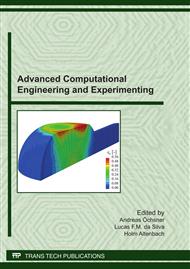[1]
S.H. Teoh,W. H . Chan and R. Thampuran: Journal of Biomechanics Vol. 35 (2002), p.323.
Google Scholar
[2]
S. Vesa and S. Ming: Wear Vol. 268 (2010), p.617.
Google Scholar
[3]
A. Unsworth, S. C. Scholes, S.L. Smith A.P.D. Elfick and H.A. Ash : Tribology and Interface Engineering Series Vol. 38 (2000), p.195.
Google Scholar
[4]
L.V. Wilches, J. A. Uribe and A. Toro: Wear Vol. 265 (2008), p.143.
Google Scholar
[5]
T. Ilchmann, M. Reimold and W. Müller-Schauenburg: A simple access to geometrical concepts. Medical Engineering & Physics Vol. 30 (2008), p.373.
Google Scholar
[6]
B. Lowry, D. David, R. Scott Corpe, N. Satya, C. Michael and T. Irina: The Journal of Arthroplasty Vol. 23 (2008), p.56.
Google Scholar
[7]
S. Affatato , G. Bersaglia , M. Rocchi , P. Taddei , C. Fagnano and A. Toni: Biomaterials Vol. 26 (2005), p.3259.
DOI: 10.1016/j.biomaterials.2004.07.070
Google Scholar
[8]
W. Qingliang, L. Jinlong and G. Shirong: Journal of Bionic Engineering Vol. 6 (2009), p.378.
Google Scholar
[9]
F. Jevan, A. Martin, B. Sonny, A. Seth Greenwald, H. David, P. Brad, R. Michael and P. Lisa: Biomaterials Vol. 30 (2009), p.5572.
Google Scholar
[10]
H. Fouad: Materials & Design Vol. 31 (2010), p.1117.
Google Scholar
[11]
A-HI. Mourad, H. Fouad and E. Rabeh: Materials & Design Vol. 30 (2009), p.4112.
Google Scholar
[12]
H. Fouad, A-HI. Mourad and D. C. Barton: Polymer Testing Vol. 24 (2005), p.549.
Google Scholar
[13]
H. Fouad, A-HI. Mourad and D.C. Barton: Plast Rubber Compos Vol. 37 (2008), p.346.
Google Scholar
[14]
S. Griza, A.N. Cê, E.P. Silva, F. Bertoni, A. Reguly and T.R. Strohaecker: Engineering Failure Analysis Vol. 16 (2009), p. (2036).
DOI: 10.1016/j.engfailanal.2009.01.004
Google Scholar
[15]
C.W. Ray, J.J. Joshua, A. Barrington and E.R. Harry: The Journal of Arthroplasty Vol. 20 (2005), p.914.
Google Scholar
[16]
S.C. Frank, E.D.C. Paul, A.K. Ashay, F.L. Jen, H.F. Victor, A.S. Steven and D.Z. Joseph: The Journal of Arthroplasty Vol. 13 (1998), p.867.
Google Scholar
[17]
R.K. Korhonen, A. Koistinen , Y.T. Konttinen , S.S. Santavirta and R. Lappalainen: BioMedical Engineering Online Vol. 4 (2005), p.32.
Google Scholar
[18]
E. Rixrath, S. Wendling-Mansuy, X. Flecher, P. Chabrand and N. Argenson: Journal of Biomechanics Vol. 41 (2008), p.1137.
DOI: 10.1016/j.jbiomech.2007.12.009
Google Scholar
[19]
T. Bertram, H. Anton, K. Johan, K. Veronika, F. Gunnar, V. Nico and D. Ron: Journal of Biomechanics Vol. 41 (2008), p.100.
Google Scholar
[20]
P.S.M. Barbour , D.C. Barton and J. Fisher: Wear Vol. 181-183 (1995), p.250.
Google Scholar
[21]
J. Hai-bo: Journal of Bionic Engineering Vol. 4 (2007), p.123.
Google Scholar
[22]
B. David and G. Tarun: Materials & Design Vol. 29 (2008), p.45.
Google Scholar
[23]
S.D. Marianne, W. Luc, D. Siegfried and S. Kai-Uwe: Medical Engineering & Physics Vol. 30 (2008), p.1186.
Google Scholar
[24]
L. Kang, A.L. Galvin, Z.M. Jin and J. Fisher: Proceedings of the Institution of Mechanical Engineers, Part H (Journal of Engineering in Medicine) Vol. 220- H1 (2006), p.33.
Google Scholar
[25]
G.B. John, K.D. Thomas, A.W. Paul and C.C. Ian: The Journal of Arthroplasty Vol. 23 (2008), p.1090.
Google Scholar
[26]
P.D.E. Alistair, M.H. Richard, M.P. Ian and U. Anthony: The Journal of Arthroplasty Vol. 13 (1998), p.291.
Google Scholar
[27]
S.M. Darwish and A.M. Al-Samhan: J. of Materials Science and Engineering Technology Vol. 40 (2009), p.218.
Google Scholar
[28]
K.M. Orhun, R.B. Charles, O'C. Daniel, S.P. Rebecca, M.E. Daniel, J. Murali and H.H. William: The Journal of Arthroplasty Vol. 16 (2001), p.24.
Google Scholar
[29]
H. Fouad: Materials and Design Vol. 31 (2010), p.1117.
Google Scholar
[30]
A. Wang, A. Essner and R. Klein: Proceedings of the Institution of Mechanical Engineers, Part H: Journal of Engineering in Medicine Vol. 215(H2) (2001), p.133.
Google Scholar
[31]
J.D. Currey: The Journal of Experimental Biology Vol. 202 (1999), p.2495.
Google Scholar


